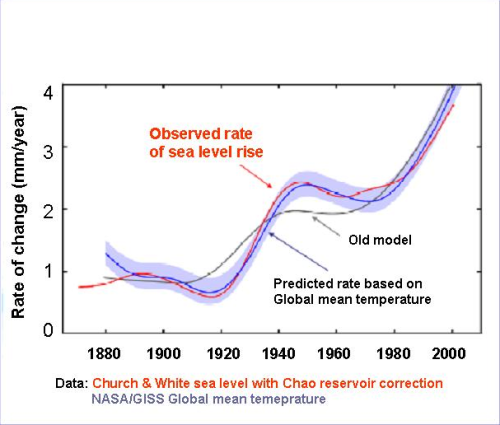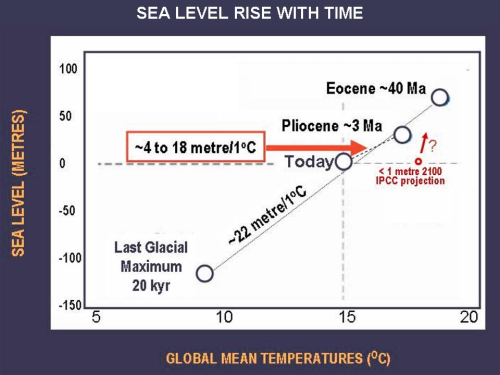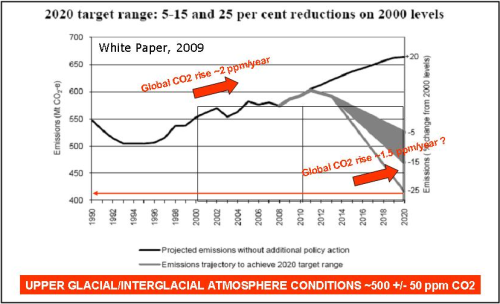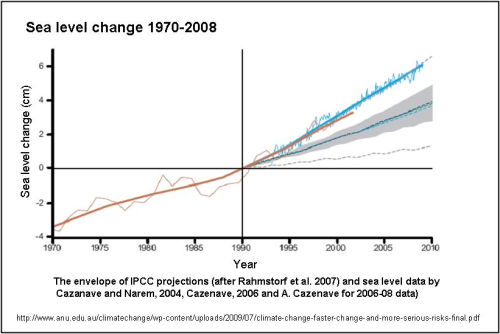“We are simply talking about the very life support system of this planet”, Professor Joachim Schellnhuber, Director, Potsdam Institute of Climate Impact, and chief climate science advisor of the German Government.
“The pace and scale of climate change may now be outstripping even the most sobering previous predictions”, United Nations Environment Programme (UNEP), Intergovernmental Panel of Climate Change (IPCC).
“The time for hesitation is over”, United Nations Secretary-General, Ban Ki-moon.
“The clock is ticking for the planet”, Kevin Rudd.
Advertisement
With the exception of rapid atmospheric changes triggered by major volcanic events, asteroid impacts and methane release, which led to the great mass extinction of species, the current rate of CO2 rise (2005-08: 1.66-2.55 ppm/year) is unprecedented in the recent history of the Earth, driving polar ice melt and sea level rise rates in excess of IPCC projections.
Warming of large parts of the Arctic and Antarctic circles by 3-4 degrees C during 1975-2009 triggers fast feedback effects from ice melt, albedo loss and open water infrared absorption, as well as from the carbon cycle.
Estimates of future sea level rise derived from 40 years records (1.6 to 3.7 mm/year), glacier flow rates and ice shelf collapse dynamics, and yet little-quantified positive feedbacks, render exponential to non-linear sea level rise on the scale of metres to tens of metres over the next decades and centuries possible.
The rise in the oceans heat content (1950-2004: 16.10^22 Joules), lowered pH (8.2 to 8.1), and enhancement of the CO3[-2] to HCO3[-] transition, threaten algae, calcifying plankton and reef habitats from shallow water to abyssal depths.
The best outcomes of the looming Copenhagen climate summit, 25 per cent carbon emission reduction relative to 1990 levels, would be unable to arrest the rise of mean global temperatures over 2 degrees Celsius relative to pre-industrial levels. The rise in CO2 emissions by 41 per cent since 1990 and continuing land clearing go counter to the urgently required measures at mitigation, massive reforestation, revegetation, application of biochar and chemical draw-down of atmospheric CO2.
Advertisement
While governments vie to vested interests and economists calculate the price of the Earth, a denial syndrome underpinned by an ideology of human mastery over nature is enhanced by a massive disinformation campaign by contrarians who ignore the basic laws of physics and chemistry and falsify climate data records.
Of all the physical and chemical indicators of climate change the rate of sea level rise is the most sensitive parameter, reflecting both thermal expansion of upper layers of the oceans and ice sheet collapse rates. The rise of sea level rates from below 1 mm/year about 1880, to about over 3.7 mm/year by 2008 (Figures 1, 2) (Rahmstorf and Vermeer, 2009), increasing rates of ice mass loss from the Greenland and Antarctic ice.

Figure 1. Sea level change 1970-2008

Figure 2. Sea level change rates (after Vermeer and Rahmstorf, 2009)
Increasing rates of ice mass loss from the Greenland and Antarctic ice sheets revealed by GRACE satellite (Geophys. Res. Lett., 36, L19503, doi:10.1029/2009GL040222 ; DOI: 10.1126/science.326_217a ; DOI: 10.1126/ science.326.5955.926) constitute the definitive warning for Homo Sapiens. In Greenland mass ice loss increased from 137 billion ton (GtI) ice/year in 2002-2003 to 286 GtI/year in 2007-2009 (doi:10.1029/2009GL040222). In Antarctica ice mass loss increased from 104 GtI/year in 2002-2006 to 246 GtI/year in 2006-2009. According to Kerr, 2009 (DOI: 10.1126/science.326_217a) “the latest analysis of the most comprehensive, essentially continuous, monitoring of the ice sheets shows that the losses have not eased in the past few years.” (Kerr, 2009 DOI: 10.1126/ science.326.5955.926).
Recent reports highlight major underestimates by IPCC reports on which most economic and government assessments since 2001, including the Stern and Garnaut reports, have been based. Economic models attempt correlations between target atmospheric CO2 stabilisation levels (cf. 450, 550, 650 ppm) and economic costs of mitigation. For example, for a range of emission scenarios, stabilisation of CO2 at 450 ppm by 2050 was purported to cost 3-4 per cent of GDP, while stabiliation at 750 ppm was supposed to cost less than 1 per cent GDP by 2050.
Early IPCC reports failed to predict the rapid loss of Arctic Sea, Greenland and west Antarctica ice over the last five years or so. In projecting sea level rises the IPCC-2007 admits, as a footnote: “Models used to date do not include uncertainties in climate-carbon cycle feedback nor do they include the full effects of changes in ice sheet flow, because a basis in published literature is lacking.” and “Model-based range excluding future rapid dynamical changes in ice flow”.
These reports contain sea level rise projections corresponding to various emission scenarios and CO2 stabilisation levels. The IPCC-2001 report projects sea level rise to up to about 85 cm by 2100. The IPCC-2007 report correlates estimates in the range of 26-59 cm with mean global temperature rise scenario of 2.4-6.4C by 2100. More recent sea level rise assessments, which take the Greenland glaciers and west Antarctic ice shelf collapse into account, project 0.8 - 2.0 metres (Pfeffer et al., 2008. Kinematic Constraints on Glacier Contributions to 21st-Century Sea-Level Rise. Science 35, 321, 1340-1343.) and 5 metres rise by 2100 (Hansen et al., 2008). On the century scale sea levels consistent with those of the Pliocene (3 million years ago) may be reached. At that stage mean global temperatures by 2 - 3 degrees C led to 25+/-12 meters sea level rise (Figure 3).

Figure 3. Long term sea level - global temperature relations (Rahmstorf, 2005) Climate Change Fact Sheet Potsdam Institute for Climate Impact Research
The cumulative nature of CO2 emissions results in committed high mean global temperatures on time scales of centuries to millennia (Eby et al., 2009. Lifetime of Anthropogenic Climate Change: Millennial Time Scales of Potential CO2 and Surface Temperature Perturbations. Journal of Climate 22, 2501-2511). The concept of “stabilisation” of atmospheric CO2 and temperature (IPCC; Wigley et al., 2007), adopted in reports by the Global Carbon Project, Garnaut Review and other, has little foundation in paleoclimate records. Amplification of CO2 and temperature rise by carbon cycle feedbacks and ice melt albedo flip feedbacks would overshoot any arbitrary ceilings inferred in the above reports. Studies of Greenland and Antarctic ice cores indicate dominance of abrupt climate changes, suggesting high sensitivity of atmospheric states to radiative forcing and feedback effects (Steffensen et al., 2008. High-resolution Greenland ice core data show abrupt climate change happens in few years. Science Express, 19.6.2008)
The current rate of CO2 rise of about 2 ppm/year exceeds that of the Paleocene-Eocene Thermal Maximum - a 55 million years-old greenhouse event which triggered the release of some 2000 billion tons of carbon as methane over a period estimated at about 1,000 years, raising atmospheric CO2 levels by about 400 ppm at a rate of about 0.4 ppm/year, resulting in temperature rise of several degrees Celsius (Zachos et al., 2001. Trends, rhythms, and aberrations in global climate 65 Ma to present. Science 292, 686-693)
The best outcome of the forthcoming UN Copenhagen meeting of 25 per cent reduction of emissions relative to 1990, now in doubt, can not avert extreme climate disruption and rising sea levels. The implications to the proposed Australian CPRS are clear

Figure 4: The 1990-2009 Australian CO2-e emissions trend, including projected decreases of 5, 15 and 25 percent between 2010-2020 relative to 2000 levels
(Australian Government White Paper). Arrows plotted by the author (AYG) denote continuing CO2 rise trajectories related to CO2 emissions, taking no account of carbon cycle
feedback effects, tracking toward the 500 ppm CO2-e level which marks the approximate upper stability limit of the Antarctic ice sheet
With an atmospheric CO2-e (a value which includes the effects of methane) at about 460 ppm (Copenhagen Synthesis Report) climate conditions are a mere 40 ppm from the CO2~500 ppm upper stability limit of the Antarctic ice sheet. Due to the cumulative nature of atmospheric CO2, intersection of this critical threshold and a rise by 2 degrees C relative to pre-industrial time threaten the onset of abrupt tipping points in the climate system, taking climate change out of human control.
Only urgent measures at global mitigation involving carbon emission cuts near-80 per cent, rapid application of clean renewable energy utilities, cessation of land clearing, extensive reforestation, global biochar and application and fast track development of chemical CO2 down-draw technologies aimed at lowering atmospheric CO2 levels to below 350 ppm (Hansen et al., 2008), can make the difference to the young and future generations.